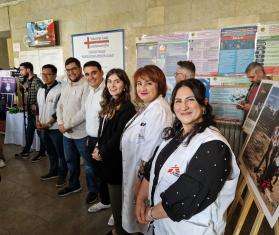January 27, 2005 - The World Health Organization released its "3 by 5" progress report on January 26, 2005 at the Davos World Economic Forum congratulating itself on progress made in the drive to fight the HIV pandemic. But only 700,000, or 12%, of the nearly six million people in need of antiretroviral (ARV) treatment in developing countries have access to it today. Looking at these figures Doctors Without Borders/Médecins Sans Frontières (MSF), who provides ARV treatment to more than 25,000 patients in 27 countries, comes to the exact opposite conclusion.
The World Health Organization released its "3 by 5" progress report on January 26, 2005 at the Davos World Economic Forum congratulating itself on progress made in the drive to fight the HIV pandemic. But only 700,000, or 12%, of the nearly six million people in need of antiretroviral (ARV) treatment in developing countries have access to it today. Looking at these figures Doctors Without Borders/Médecins Sans Frontières (MSF), who provides ARV treatment to more than 25,000 patients in 27 countries, comes to the exact opposite conclusion.
Instead of celebrating, WHO, UNAIDS, the Global Fund, the US President's Emergency Plan for AIDS Relief (PEPFAR) and other institutions should be sounding the alarm. Every day, more than 8,000 people die from AIDS and every year another five million become infected with HIV. Since July 2004, only 260,000 new patients have benefited from ARV therapy in developing countries. Treatment expansion is moving at a snail's pace. From the perspective of a medical humanitarian organization working in resource-poor countries to treat people with AIDS, the global picture is bleak.
Crucial issues around AIDS treatment remain un-tackled:
- Children continue to be a neglected population. There are few adapted and affordable pediatric formulations for the 2.2 million children living with HIV, and few diagnostic and monitoring tools suited to their needs. WHO and UNICEF continue to fail to address this.
- Due to lack of generic competition, much-needed second-line medicines are already two to 12 times more expensive than the most affordable WHO-recommended first-line generics. WHO itself describes ARV prices as an "increasingly serious public health hazard". Thus far, however, WHO and others are demanding nothing of governments or pharmaceutical companies and offer no practical solutions.
- Trade rules are interfering with generic competition, which has brought the prices of AIDS drugs down dramatically and was a prerequisite for getting donors and national governments to commit to treatment. January 2005 marks a new threat to access to medicines. India, where most of the largest producers of generic ARVs are located, no longer has the right to produce generic versions of new drugs because it is implementing the World Trade Organization (WTO) Agreement on Trade-related Aspects of Intellectual Property Rights (TRIPS). This will most likely lead to a steep rise in the prices of any new drugs to treat AIDS: if the prices of second-line medicines are any indication, we are in for steep price increases.
- WHO must do much more to strengthen its pre-qualification project and the US government and pharmaceutical industry (and the private groups they fund) must stop undermining confidence in generic medicines through inaccurate and irresponsible public campaigns, but there was little discussion of this in Davos.
- The institutions gathered in Davos claimed that the many mechanisms to fund the fight against AIDS are working "in tandem" to achieve the acclaimed success. This simply isn't true. PEPFAR projects are often at odds with Global Fund projects and national policies in terms of procurement and distribution of drugs, processes for evaluating quality, safety, and efficacy of medicines, and coherence with national protocols. In fact, because of these policy inconsistencies, PEPFAR has recently been criticized for having a smaller selection of ARVs available for its 15 "focus countries" than other treatment initiatives and for spending far more money than other initiatives on these ARVs.
- On January 26, the US Government Accountability Office released a report which found that PEPFAR pays US$ 40-368 more than other AIDS initiatives per patient per year for first-line regimens because it relies only on FDA approved drugs and "does not include some FDCs that are preferred by some of the focus countries". The report explains that "for every 100,000 patients on this regimen [d4T+3TC+NVP] for 5 years, the plan could pay over US$ 170 million more than the other initiatives". In other words, PEPFAR could be treating thousands more people with the funds it is spending.
- Finally, the lack of investment into research and development (R&D) for new preventive, diagnostic, monitoring, and therapeutic tools adapted for use in resource-limited settings is completely off the international political agenda. New tools to diagnose HIV in children under 18 months, to diagnose TB, and detect treatment failure, for example, are urgently needed in the field as are new and adapted drugs, vaccines and microbicides.
Unless these and other pressing issues are addressed urgently, many of those living with HIV/AIDS in developing countries will never get access to life-saving treatment or may not be able to survive once on treatment over the long-term.



